Magnetoelectric Effects in Bilayers of PZT and Co and Ti Substituted M-Type Hexagonal Ferrites
Abstract
1. Introduction
2. Experiment
3. Results
3.1. Structural Characterization and Morphological Features
3.2. Magnetization
3.3. Magnetostriction
3.4. Ferromagnetic Resonance
3.5. ME Effects in Bilayers of BCTx/SCTx and PZT
4. Discussion
5. Conclusions
Supplementary Materials
Author Contributions
Funding
Data Availability Statement
Conflicts of Interest
References
- Tkachenko, M.V.; Ol’khovik, L.P.; Kamzin, A.S. Magnetic ceramics based on hydroxyapatite modified by particles of M-type hexagonal ferrite for medical applications. Phys. Solid State 2011, 53, 1588–1593. [Google Scholar] [CrossRef]
- Belous, A.G.; Solovyova, E.D.; Solopan, S.O.; Yelenich, O.V.; Bubnovskaya, L.N.; Osinsky, S.P. Properties and potential applications of ferromagnetic nanostructures in medicine and microwave engineering. Solid State Phenom. 2015, 230, 95–100. [Google Scholar] [CrossRef]
- Pullar, R.C. Hexagonal ferrites: A review of the synthesis, properties and applications of hexaferrite ceramics. Progr. Mater. Sci. 2012, 57, 1191–1334. [Google Scholar] [CrossRef]
- Wohlfarth, E.P. (Ed.) Ferromagnetic Materials; North-Holland Publishing Company: Amsterdam, The Netherlands, 1980; Volume 2. [Google Scholar]
- Smit, J.; Wijn, H.P.J. Ferrites; Phillips Technical Library: Eindhoven, The Netherlends, 1959. [Google Scholar]
- Sugimoto, M. The past, present, and future of ferrites. J. Am. Ceram. Soc. 1999, 82, 269–280. [Google Scholar] [CrossRef]
- Brawn, R.B. The crystal structure of a new group of ferromagnetic compounds. Philips Res. Rep. 1957, 12, 491–548. [Google Scholar]
- Kimura, T. Magnetoelectric hexaferrites. Annu. Rev. Condens. Matter Phys. 2012, 3, 93–110. [Google Scholar] [CrossRef]
- Kimura, T.; Lawes, G.; Ramirez, A.P. Electric polarization rotation in a hexaferrite with long-wavelength magnetic structures. Phys. Rev. Lett. 2005, 94, 137201. [Google Scholar] [CrossRef]
- Ishiwata, S.; Taguchi, Y.; Murakawa, H.; Onose, Y.; Tokura, Y. Low-magnetic-field control of electric polarization vector in a helimagnet. Science 2008, 319, 1643–1646. [Google Scholar] [CrossRef]
- Taniguchi, K.; Abe, N.; Ohtani, S.; Umetsu, H.; Arima, T.H. Ferroelectric polarization reversal by a magnetic field in multiferroic Y-type hexaferrite Ba2Mg2Fe12O22. Appl. Phys. Express 2008, 1, 031301. [Google Scholar] [CrossRef]
- Ishiwata, S.; Okuyama, D.; Kakurai, K.; Nishi, M.; Taguchi, Y.; Tokura, Y. Neutron diffraction studies on the multiferroic conical magnet Ba2Mg2Fe12O22. Phys. Rev. B 2010, 81, 174418. [Google Scholar] [CrossRef]
- Kitagawa, Y.; Hiraoka, Y.; Honda, T.; Ishikura, T.; Nakamura, H.; Kimura, T. Low-field magnetoelectric effect at room temperature. Nat. Mater. 2010, 9, 797–802. [Google Scholar] [CrossRef]
- Soda, M.; Ishikura, T.; Nakamura, H.; Wakabayashi, Y.; Kimura, T. Magnetic Ordering in Relation to the Room-Temperature Magnetoelectric Effect of Sr3Co2Fe24O41. Phys. Rev. Lett. 2011, 106, 087201. [Google Scholar] [CrossRef]
- Kumar, K.; Mishra, S.K.; Singh, S.; Baev, I.; Martins, M.; Orlandi, F.; Manuel, P.; Pandey, D. Evidence for Conical Magnetic Structure in M-Type BaFe12O19 Hexaferrite: A Combined Single-Crystal X-ray Magnetic Circular Dichroism and Neutron Diffraction Study. Phys. Status Solidi (RRL) 2021, 15, 2000506. [Google Scholar] [CrossRef]
- Ebnabbasi, K.; Mohebbi, M.; Vittoria, C. Room temperature magnetoelectric effects in bulk poly-crystalline materials of M-and Z-type hexaferrites. J. Appl. Phys. 2013, 113, 17C703. [Google Scholar] [CrossRef]
- Aleshko-Ozhevskii, O.P.; Sizov, R.A.; Cheparin, V.P.; Yazmin, I.I. Helicoidal Antiphase Spin Ordering in Hexagonal Ferrites with Magnetoplumbite Structure. J. Exp. Theor. Phys. Lett. 1968, 7, 207. [Google Scholar]
- Wang, L.; Wang, D.; Cao, Q.; Zheng, Y.; Xuan, H.; Gao, J.; Du, Y. Electric control of magnetism at room temperature. Sci. Rep. 2012, 2, 223. [Google Scholar] [CrossRef]
- Ryu, J.; Carazo, A.V.; Uchino, K.; Kim, H.E. Magnetoelectric properties in piezoelectric and magnetostrictive laminate composites. Jpn. J. Appl. Phys. 2001, 40, 4948–4951. [Google Scholar] [CrossRef]
- Nan, C.W.; Bichurin, M.I.; Dong, S.; Viehland, D.; Srinivasan, G. Multiferroic magnetoelectric composites: Historical perspective, status, and future directions. J. Appl. Phys. 2008, 103, 031101. [Google Scholar] [CrossRef]
- Ortega, N.; Kumar, A.; Scott, J.F.; Katiyar, R.S. Multifunctional magnetoelectric materials for device applications. J. Phys. Condens. Matter 2015, 27, 504002. [Google Scholar] [CrossRef]
- Spaldin, N.A.; Ramesh, R. Advances in magnetoelectric multiferroics. Nat. Mater. 2019, 18, 203–212. [Google Scholar] [CrossRef]
- Liu, N.; Du, P.; Zhou, P.; Tanguturi, R.G.; Qi, Y.; Zhang, T. Magnetoelectric coupling in CoFe2O4-Pb (Zr0. 2Ti0. 8) O3 coaxial nanofibers. J. Am. Ceram. Soc. 2021, 104, 948–954. [Google Scholar] [CrossRef]
- Jiang, Q.H.; Shen, Z.J.; Zhou, J.P.; Shi, Z.; Nan, C.W. Magnetoelectric composites of nickel ferrite and lead zirconnate titanate prepared by spark plasma sintering. J. Eur. Ceram. Soc. 2007, 27, 279–284. [Google Scholar] [CrossRef]
- Bichurin, M.; Petrov, R.; Tatarenko, A. Magnetoelectric composites: Modeling and application. Adv. Mater. 2020, 9, 10-11648. [Google Scholar] [CrossRef]
- Bochenek, D.; Niemiec, P.; Brzezińska, D.; Dercz, G.; Ziółkowski, G.; Jartych, E.; Grotel, J.; Suchanicz, J. Magnetoelectric properties of multiferroic composites based on BaTiO3 and nickel-zinc ferrite material. Materials 2024, 17, 1905. [Google Scholar] [CrossRef]
- Premkumar, S.; Mathe, V.L. Effect of co-sintering time on magnetoelectric response of Pb0.895Sr0.06La0.03(Zr0.56Ti0.44)O3 multilayer-Ni0.6Zn0.4Fe2O4 composite fabricated by tape casting. J. Appl. Phys. 2019, 126, 084106. [Google Scholar]
- Zhang, J.; Du, H.; Xia, X.; Fang, C.; Weng, G.J. Theoretical study on self-biased magnetoelectric effect of layered magnetoelectric composites. Mech. Mater. 2020, 151, 103609. [Google Scholar] [CrossRef]
- Deka, B.; Lee, Y.W.; Yoo, I.R.; Gwak, D.W.; Cho, J.; Song, H.C.; Choi, J.J.; Hahn, B.D.; Ahn, C.W.; Cho, K.H. Designing ferroelectric/ferromagnetic composite with giant self-biased magnetoelectric effect. Appl. Phys. Lett. 2019, 115, 192901. [Google Scholar] [CrossRef]
- Annapureddy, V.; Park, S.H.; Song, H.; Ryu, J. Tunable self-biased magnetoelectric effect in magnetization-graded magnetoelectric composites. J. Alloys Compd. 2023, 957, 170121. [Google Scholar] [CrossRef]
- Mathe, V.L.; Srinivasan, G.; Balbashov, A.M. Magnetoelectric effects in bilayers of lead zirconate titanate and single crystal hexaferrites. Appl. Phys. Lett. 2008, 92, 122505. [Google Scholar] [CrossRef]
- Saha, S.; Acharya, S.; Popov, M.; Sauyet, T.; Pfund, J.; Bidthanapally, R.; Jain, M.; Page, M.R.; Srinivasan, G. A Novel Spinel Ferrite-Hexagonal Ferrite Composite for Enhanced Magneto-Electric Coupling in a Bilayer with PZT. Sensors 2023, 23, 9815. [Google Scholar] [CrossRef]
- Jing, Y.; Jia, L.; Zheng, Y.; Zhang, H. Hydrothermal synthesis and competitive growth of flake-like M-type strontium hexaferrite. RSC Adv. 2019, 9, 33388–33394. [Google Scholar] [CrossRef]
- Urquhart, H.M.; Goldman, J.E. Magnetostrictive effects in an antiferromagnetic hematite crystal. Phys. Rev. 1956, 101, 1443. [Google Scholar] [CrossRef]
- Cullity, B.D.; Graham, C.D. Introduction to Magnetic Materials; John Wiley & Sons, Inc.: Hoboken, NJ, USA, 2009. [Google Scholar]
- Hu, Z.; Stenning, G.B.; Koval, V.; Wu, J.; Yang, B.; Leavesley, A.; Wylde, R.; Reece, M.J.; Jia, C.; Yan, H. Terahertz faraday rotation of SrFe12O19 hexaferrites enhanced by Nb doping. ACS Appl. Mater. Interfaces 2022, 14, 46738–46747. [Google Scholar] [CrossRef]
- Liu, C.; Kan, X.; Hu, F.; Liu, X.; Feng, S.; Hu, J.; Wang, W.; Rehman, K.M.U.; Shezad, M.; Zhang, C.; et al. Characterizations of magnetic transition behavior and electromagnetic properties of Co-Ti co-substituted SrM-based hexaferrites SrCoxTixFe12-2xO19 compounds. J. Alloys Compd. 2019, 784, 1175–1186. [Google Scholar] [CrossRef]
- Lechevallier, L.; Le Breton, J.M.; Teillet, J.; Morel, A.; Kools, F.; Tenaud, P. Mössbauer investigation of Sr1-xLaxFe12-yCoyO19 ferrites. Phys. B Condens. Matter 2003, 327, 135–139. [Google Scholar] [CrossRef]
- Williams, J.M.; Adetunji, J.; Gregori, M. Mössbauer spectroscopic determination of magnetic moments of Fe3+ and Co2+ in substituted barium hexaferrite, Ba(Co,Ti)xFe(12−2x) O19. J. Magn. Magn. Mater. 2000, 220, 124–128. [Google Scholar] [CrossRef]
- Ustinov, A.B.; Tatarenko, A.S.; Srinivasan, G.; Balbashov, A.M. Al substituted Ba-hexaferrite single-crystal films for millimeter-wave devices. J. Appl. Phys. 2009, 105, 023908. [Google Scholar] [CrossRef]
- Sheen, J. Comparisons of microwave dielectric property measurements by transmission/reflection techniques and resonance techniques. Meas. Sci. Technol. 2009, 20, 042001. [Google Scholar] [CrossRef]
- De Bitetto, D.J. Anisotropy fields in hexagonal ferrimagnetic oxides by ferrimagnetic resonance. J. Appl. Phys. 1964, 35, 3482–3487. [Google Scholar] [CrossRef]
- Zhuravlev, V.A.; Naiden, E.P.; Shestakov, A.S.; Erkaev, P.V. Ferromagnetic Resonance Spectra in Hexaferrites of Sr(CoxTix)Fe12-2xO19 System Obtained by the SHS Method. Russ. Phys. J. 2013, 55, 1229–1231. [Google Scholar] [CrossRef]
- Sánchez, Y.; Briceño, S.; Larionova, J.; Long, J.; Guari, Y.; Silva, P. Temperature dependence of the ferromagnetic resonance (FMR) for MnxCo1−xFe2O4 (0 ≤ x ≤ 1) nanoparticles. J. Mater. Res. 2021, 36, 3329–3338. [Google Scholar] [CrossRef]
- Guerra, J.D.; Betal, S.; Pal, M.; Garcia, J.E.; Oliveira, A.J.; M’Peko, J.C.; Hernandes, A.C.; Guo, R.; Bhalla, A.S. Magnetoelectric response in (1 − x)PbZr0.65Ti0.35O3−xBaFe12O19 multiferroic ceramic composites. J. Am. Ceram. Soc. 2015, 98, 1542–1547. [Google Scholar] [CrossRef]
- Palneedi, H.; Maurya, D.; Kim, G.Y.; Priya, S.; Kang, S.J.L.; Kim, K.H.; Choi, S.Y.; Ryu, J. Enhanced off-resonance magnetoelectric response in laser annealed PZT thick film grown on magnetostrictive amorphous metal substrate. Appl. Phys. Lett. 2015, 107, 012904. [Google Scholar] [CrossRef]
- Ryu, J.; Priya, S.; Uchino, K.; Kim, H.E. Magnetoelectric effect in composites of magnetostrictive and piezoelectric materials. J. Electroceram. 2002, 8, 107–119. [Google Scholar] [CrossRef]
- Ryu, J.; Priya, S.; Carazo, A.V.; Uchino, K.; Kim, H.E. Effect of the magnetostrictive layer on magnetoelectric properties in lead zirconate titanate/terfenol-D laminate composites. J. Am. Ceram. Soc. 2001, 84, 2905–2908. [Google Scholar] [CrossRef]
- Lu, S.G.; Jin, J.Z.; Zhou, X.; Fang, Z.; Wang, Q.; Zhang, Q.M. Large magnetoelectric coupling coefficient in poly (vinylidene fluoride-hexafluoropropylene)/Metglas laminates. J. Appl. Phys. 2011, 110, 104103. [Google Scholar] [CrossRef]
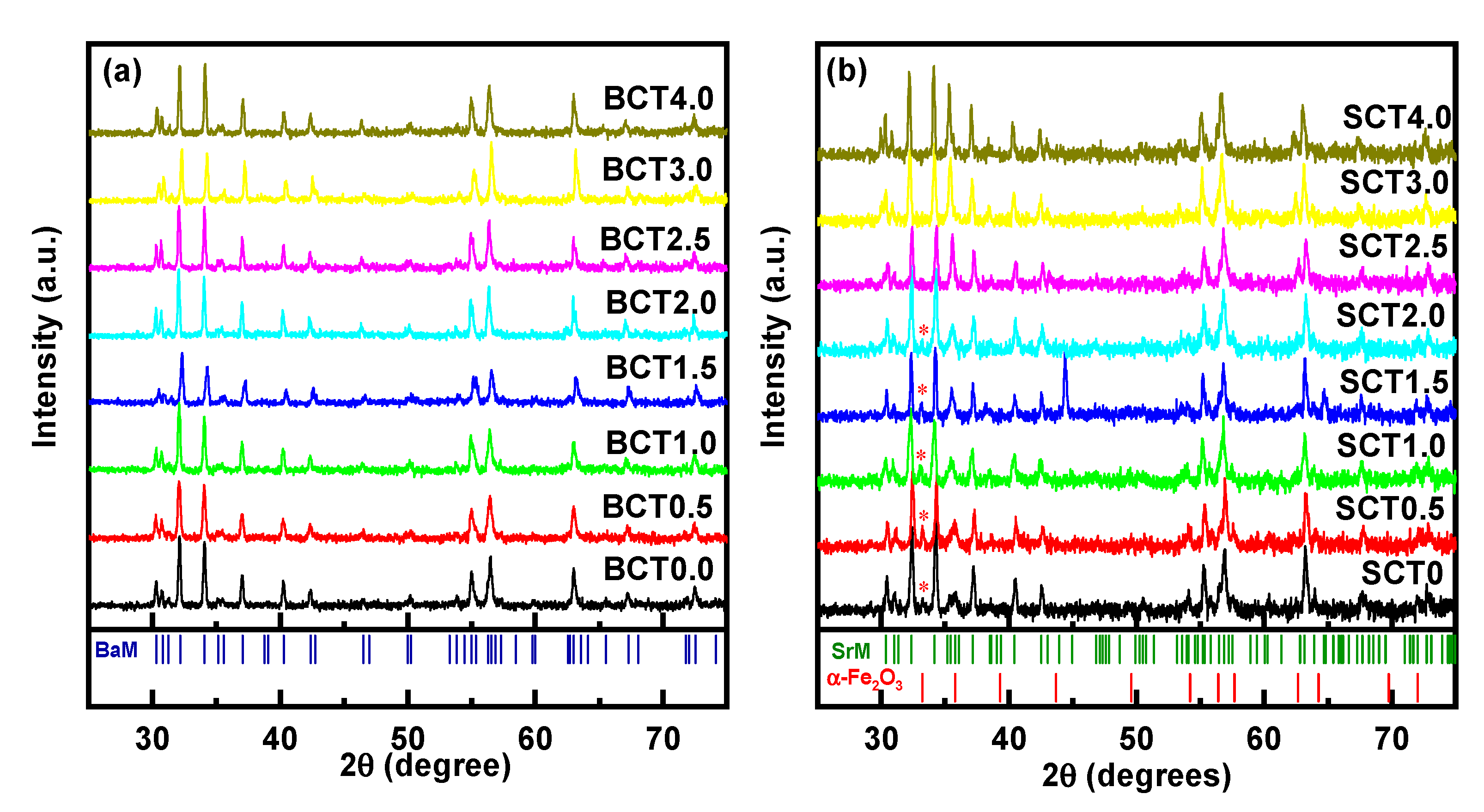

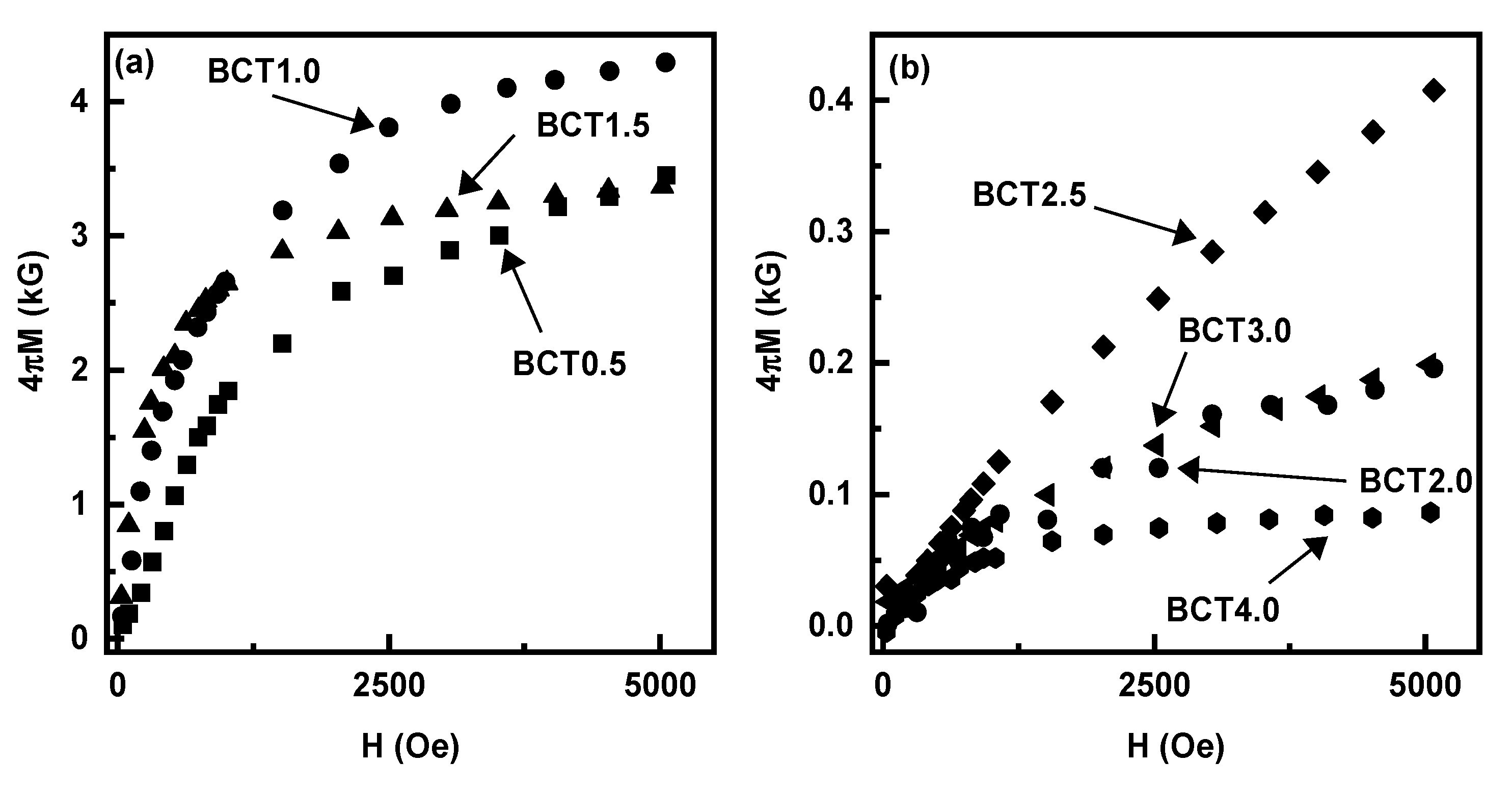
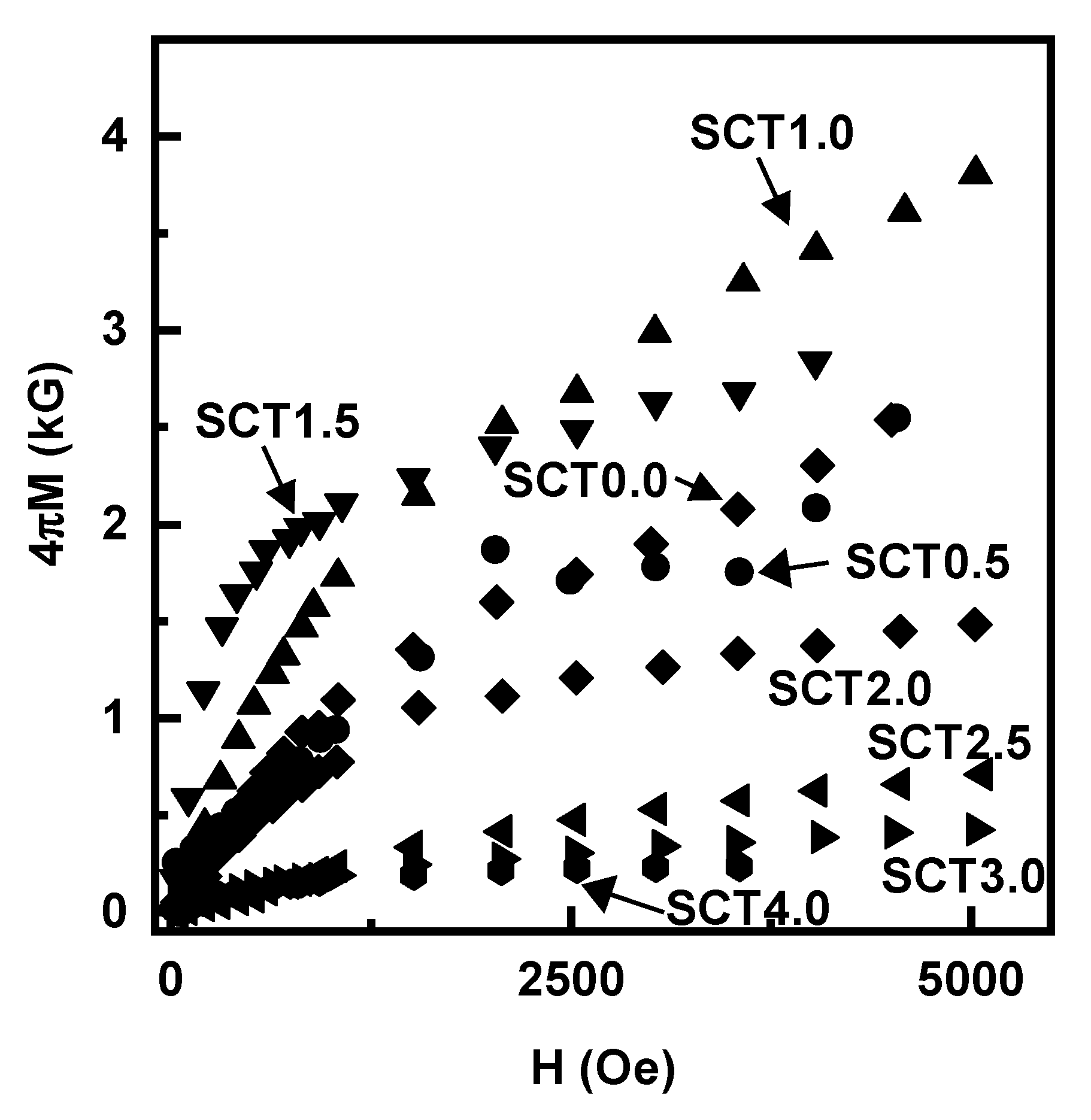
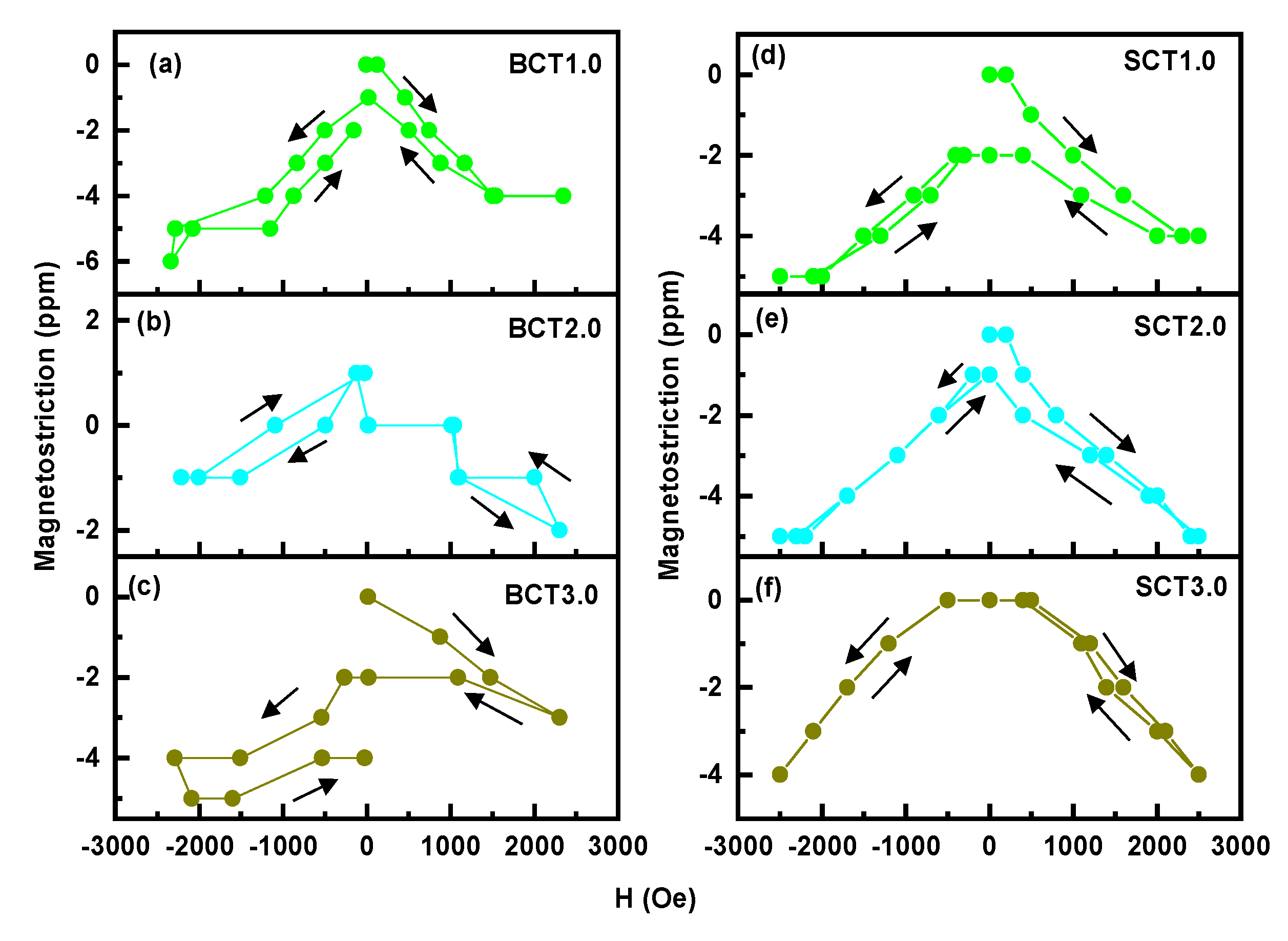
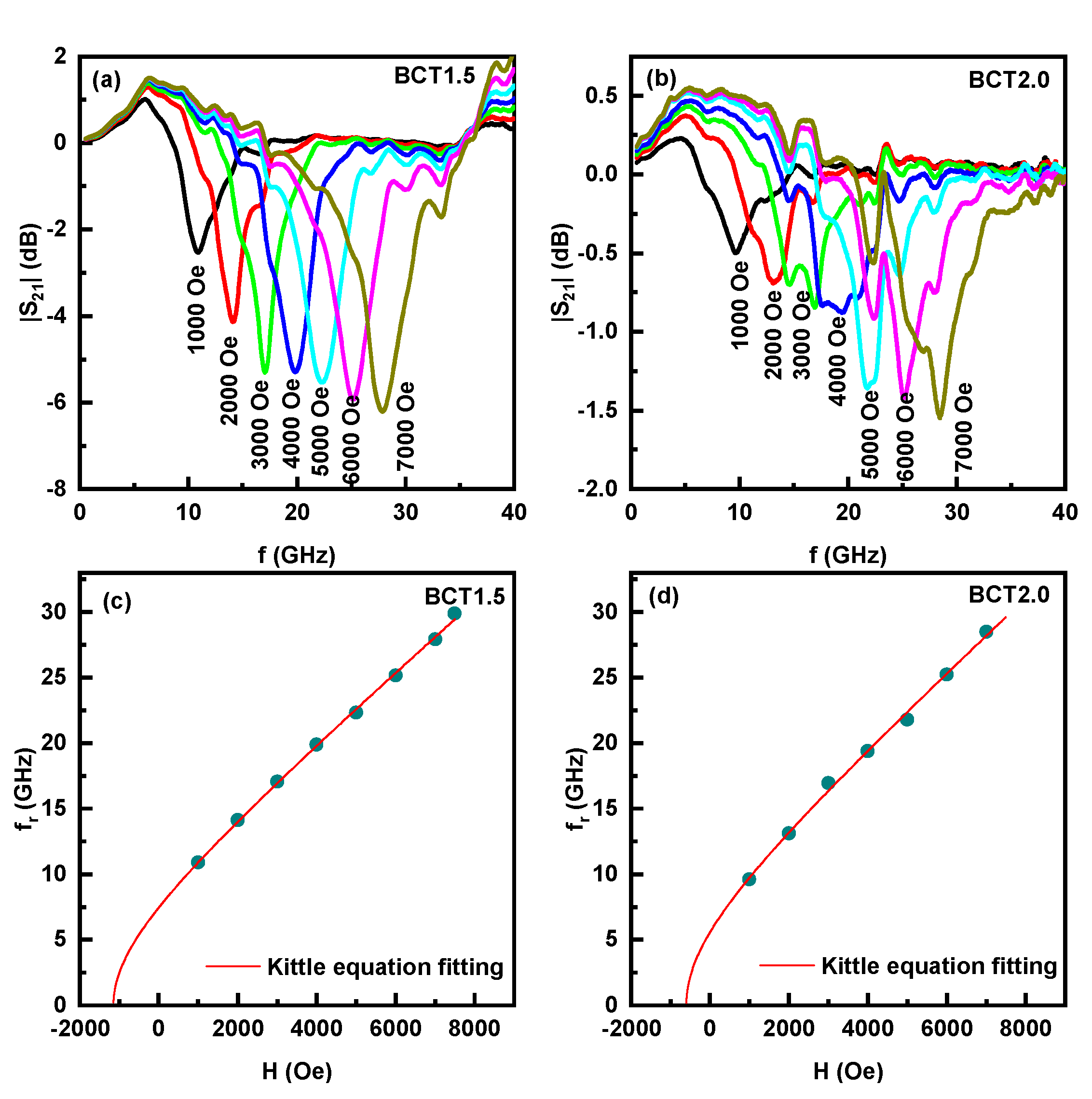

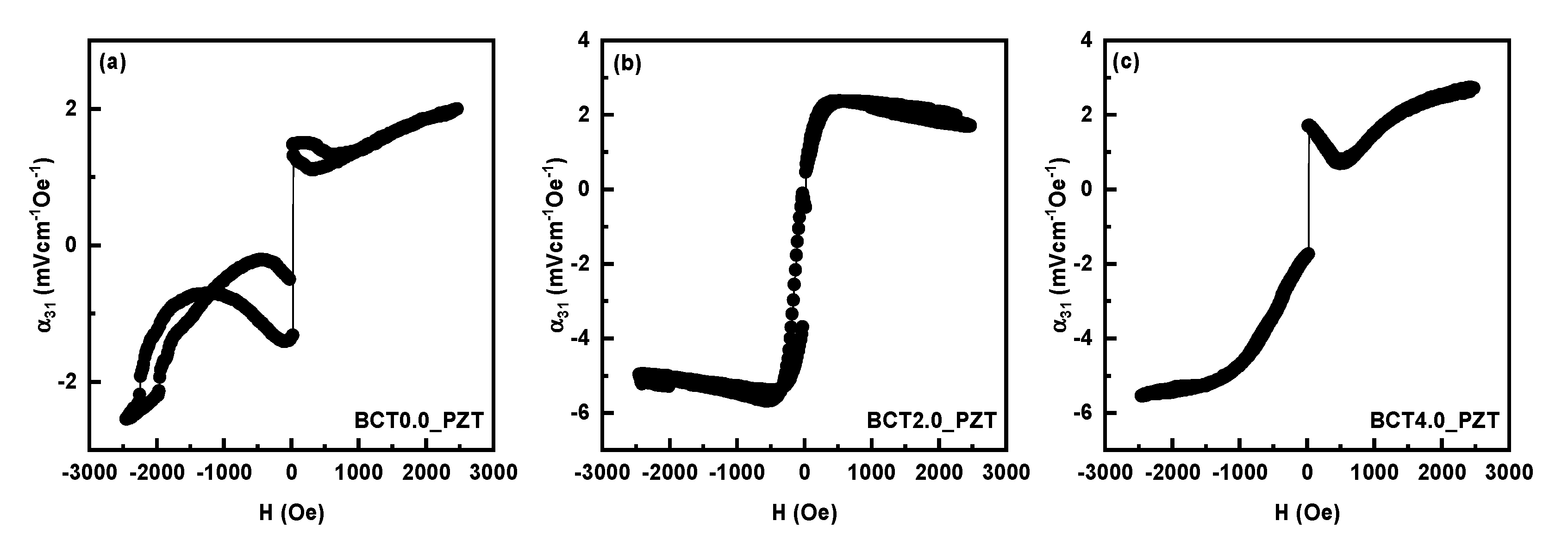
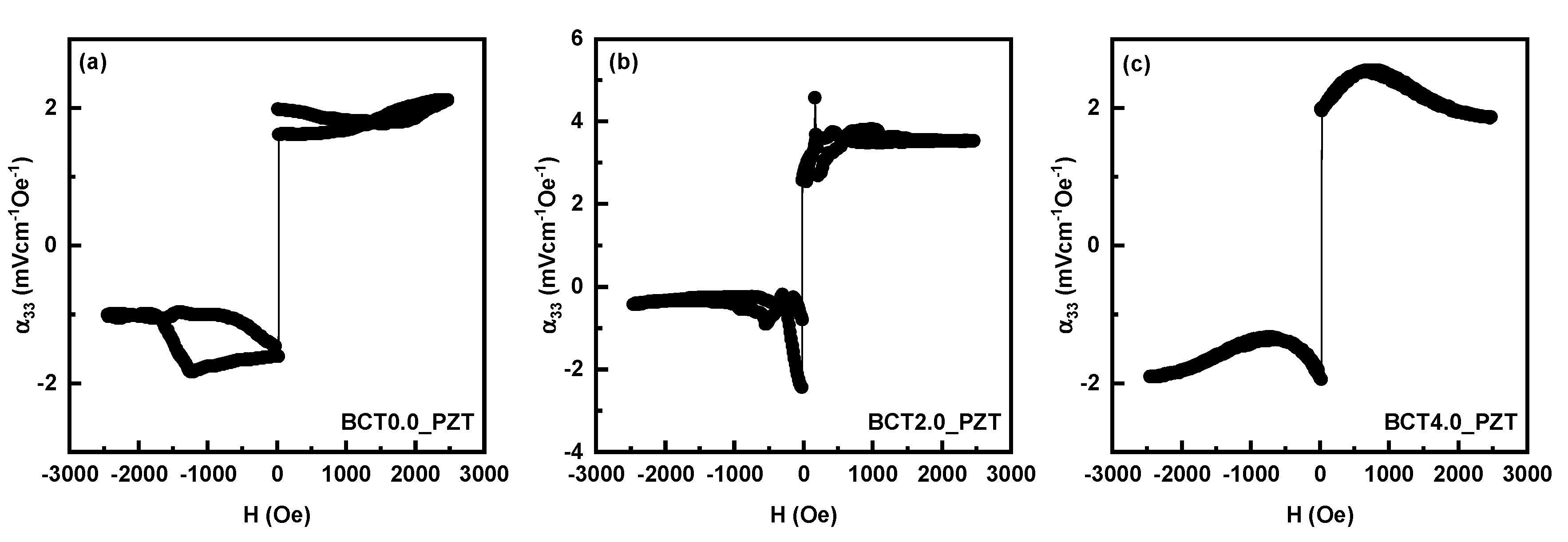

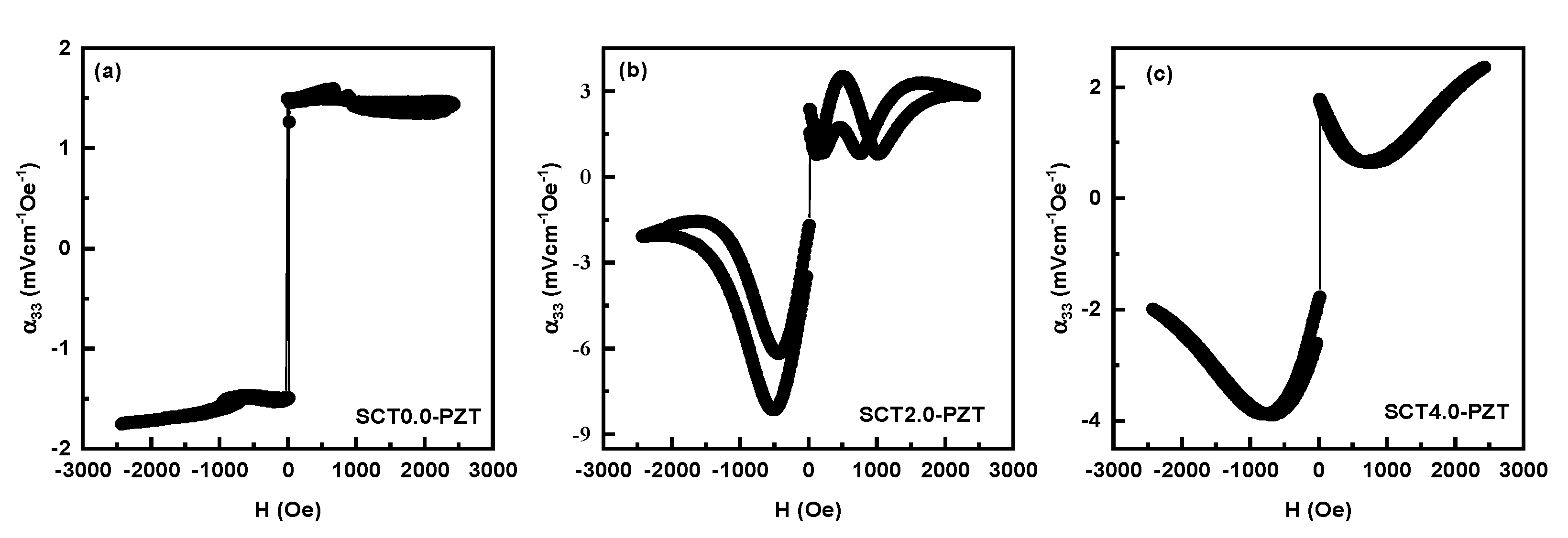
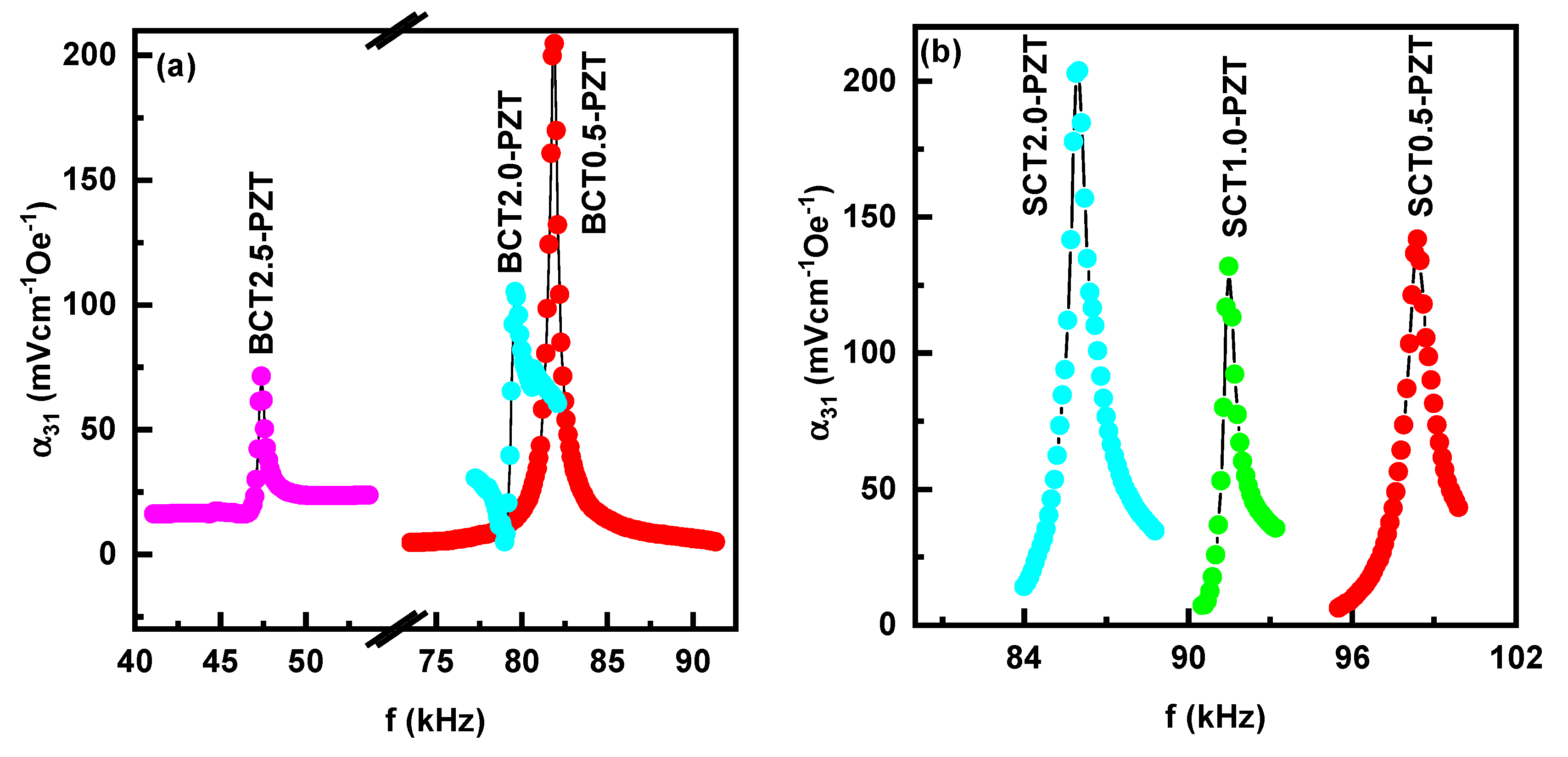
| Sample | Fitting Parameters | |||
|---|---|---|---|---|
| γ (MHz/Oe) | 4πMeff (kg) | 4πM (kg) from Figure 4 | HA (kOe) | |
| BCT1.5 | 2.63 | 9.46 | 3.29 | 6.17 |
| BCT2.0 | 2.75 | 8.19 | 0.17 | 8.02 |
| SCT1.5 | 2.80 | 7.74 | 2.84 | 4.90 |
| SCT2.0 | 3.08 | 6.37 | 1.27 | 5.10 |
Disclaimer/Publisher’s Note: The statements, opinions and data contained in all publications are solely those of the individual author(s) and contributor(s) and not of MDPI and/or the editor(s). MDPI and/or the editor(s) disclaim responsibility for any injury to people or property resulting from any ideas, methods, instructions or products referred to in the content. |
© 2025 by the authors. Licensee MDPI, Basel, Switzerland. This article is an open access article distributed under the terms and conditions of the Creative Commons Attribution (CC BY) license (https://creativecommons.org/licenses/by/4.0/).
Share and Cite
Saha, S.; Acharya, S.; Menon, S.; Bidthanapally, R.; Page, M.R.; Jain, M.; Srinivasan, G. Magnetoelectric Effects in Bilayers of PZT and Co and Ti Substituted M-Type Hexagonal Ferrites. J. Compos. Sci. 2025, 9, 336. https://doi.org/10.3390/jcs9070336
Saha S, Acharya S, Menon S, Bidthanapally R, Page MR, Jain M, Srinivasan G. Magnetoelectric Effects in Bilayers of PZT and Co and Ti Substituted M-Type Hexagonal Ferrites. Journal of Composites Science. 2025; 9(7):336. https://doi.org/10.3390/jcs9070336
Chicago/Turabian StyleSaha, Sujoy, Sabita Acharya, Sidharth Menon, Rao Bidthanapally, Michael R. Page, Menka Jain, and Gopalan Srinivasan. 2025. "Magnetoelectric Effects in Bilayers of PZT and Co and Ti Substituted M-Type Hexagonal Ferrites" Journal of Composites Science 9, no. 7: 336. https://doi.org/10.3390/jcs9070336
APA StyleSaha, S., Acharya, S., Menon, S., Bidthanapally, R., Page, M. R., Jain, M., & Srinivasan, G. (2025). Magnetoelectric Effects in Bilayers of PZT and Co and Ti Substituted M-Type Hexagonal Ferrites. Journal of Composites Science, 9(7), 336. https://doi.org/10.3390/jcs9070336







